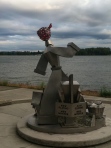A few years ago, at a Seattle neighborhood block party, an elderly lady named Fern told the assembled youngsters how it went down on December 7, 1941.
“It gets dark pretty early that time of year. For the past few hours, everybody had been running around trying to figure out where Pearl Harbor was and what the President would do about it. Then, we heard that groups of people were smashing out the streetlights so the Japanese couldn’t see us. Everyone was glued to the radio. Then, they came on and said, ‘the miliary authorities have advised us to shut down our transmitters so the signal won’t serve as a beacon for a Japanese attack. Good night and good luck.’
“Now we’re completely in the dark. Think we were scared? Hell yes, we were scared. We were scared for about a year.”
A few weeks into the new year, Fern got a job building electric motors.
Recently, during a break in a Job Instruction TWI session at a Vancouver hotel, one of my older students commented, “My mom was a welder at the Kaiser shipyards during the war. I guess there were thousands of them. Have you ever seen the statue they put up for them?”
Later that afternoon, I walked down to the river to see “Wendy Rose”, a statue erected in 2008 to honor the women who worked the shipyards on the Columbia River during WWII.
The name “Wendy Rose” comes from a co-joining of two folk heroes of the time – Wendy the Welder and Rosie the Riveter. Located a little east of the McMenamin’s and Beaches restaurants, there are commemorative plaques, names of donors engraved in stone, benches to sit on and one amazing steel statue. It’s a good place to sit and consider the work done there seventy years ago.
I’ve been teaching Job Instruction for three years now. The methods haven’t changed a bit since their introduction in 1940. The language in the materials sounds a little dated, but it works. Job Instruction trains people how to train people.
Supervisors then had the same concerns as supervisors now. Who needs to be trained? In what? How much time have I got to train them before I get called up? And the question that kept them awake at night…can they do it after I’m gone?
It’s the same story today. Workers are required to know more, to learn more, to do more with less. Supervisors have to provide the tools and skills their workers need. And supervisors still ask, “Can they do it?”
In 1944, Kaiser Shipyards Portland employed 28,000 women. Nearly one-third of the workforce was female. An onsite daycare looked after 4,000 children on a 24/7 basis. Those women learned to weld, learned to rivet, learned to do the impossible with the help of the TWI Job Instruction program. They taught each other how to cope, how to carry on in a world that had suddenly gone dark.

November 4, 2011 at 9:41 pm |
Thank you so much for this post. I moved to Vancouver in 2008 and fell in love with the statue. I walk the waterfront often — even more frequently now that I have a dog. I just love this statue. So thank you for providing more background on it.